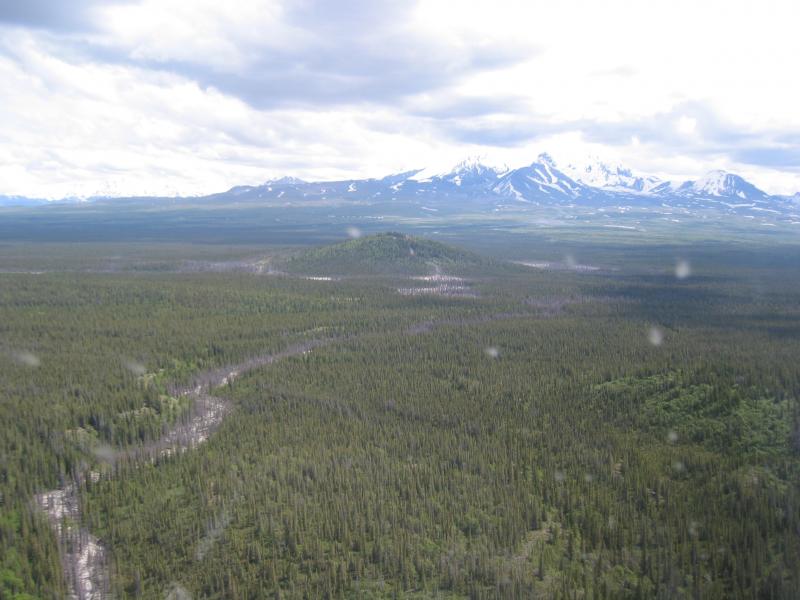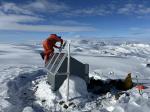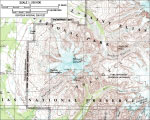Drum
Spurr
Great Sitkin
Akutan
Aniakchak
Atka volcanic complex
Augustine
Cleveland
Dutton
Edgecumbe
Fisher
Gareloi
Great Sitkin
Griggs
Iliamna
Isanotski
Kanaga
Katmai
Little Sitkin
Mageik
Makushin
Martin
Novarupta
Pavlof
Redoubt
Semisopochnoi
Shishaldin
Snowy
Spurr
Takawangha
Tanaga
Trident
Ugashik-Peulik
Ukinrek Maars
Veniaminof
Westdahl
Wrangell
Legend
✕
| Red (Warning) | |
| Orange (Watch) | |
| Yellow (Advisory) | |
| Green (Normal) | |
| Uninstrumented | |
| Community | |
| Webcam | |
| Instrument | |
| Earthquake Magnitude | |
|
0
| |
| Earthquake Age | |
| Last 2 Hours | |
| Last 2 Days | |
| Last 1 Week | |
Facts
- Official Name: Mount Drum
- Seismically Monitored: No
- Color Code: UNASSIGNED
- Alert Level: UNASSIGNED
- Elevation: 3661m (12011ft)
- Latitude: 62.1159
- Longitude: -144.6399
- Smithsonian VNum:
- Pronunciation:
-
Nearby Towns:
- Copper Center 24 mi (39 km) SW
- Silver Springs 24 mi (38 km) SW
- Gakona 25 mi (40 km) NW
- Copperville 25 mi (41 km) SW
- Gulkana 26 mi (42 km) NW
Distance from Anchorage: 183 mi (295 km)
-
Subfeatures:
- Snider Peak
- Ruddy Mtn
Description
From Wood and Kienle (1990) [1] : "Mount Drum, the westernmost volcano in the Wrangell volcanic field, was formed between ~0.65 and 0.24 Ma during at least two cycles of cone-building and ring-dome extrusion. The first cycle began with the construction of a cone consisting chiefly of andesite and dacite lava flows, breccias, lahars, and tuffs, and culminated with the emplacement of a series of rhyolite ring domes around the cone's southeast flank. The second cycle of activity, following without an apparent time break, continued to build the cone but with more dacitic flows and fewer pyroclastic and volcaniclastic deposits. This stage was followed by the emplacement of at least nine dacitic domes that lie on 270 degrees of arc, crudely defining a circle ~12-13 km in diameter centered approximately at the present summit of Mount Drum. The rhyodacite dome of Snider Peak and its massive dacite flows erupted late in the second cycle, probably marking the end of major constructive activity. Following the second cycle, paroxysmal explosive activity, probably from the central vent area, destroyed the south half of the stratovolcano and deposited ~7 cubic km of hot and cold avalanche debris over an area >200 square km."Name Origin
Mount Drum was named by Lt. Allen in 1885, for Adj. General Richard Coulter Drum, 1825-1909, who entered the army in 1846, served in the Mexican War, participated in an expedition against the Sioux Indians in 1856, and became a Brigadier General during the Civil War (Orth, 1971).
References Cited
[1] Volcanoes of North America: United States and Canada, 1990
Wood, C. A., and Kienle, Juergen, (eds.), 1990, Volcanoes of North America: United States and Canada: New York, Cambridge University Press, 354 p.Reported Activity
Modern Eruptions
6 Event Date(s)
Past Activity Legend:
| Eruption | |
| Questionable eruption | |
| Non-eruptive activity |
Showing 1 - 9 of 9
Map Images
Map References
Geologic map of the Valdez D-1 and D-2 quadrangles (Mount Wrangell Volcano), Alaska, 2016
Richter, D.H., McGimsey, R.G., Labay, K.A., Lanphere, M.A., Moore, R.B., Nye, C.J., Rosenkrans, D.S., and Winkler, G.R., 2016, Geologic map of the Valdez D-1 and D-2 quadrangles (Mount Wrangell Volcano), Alaska: U.S. Geological Survey Scientific Investigations Map 3351, 20 p., scale 1:63,360, http://dx.doi.org/10.3133/sim3351.
Geologic map of the Wrangell-Saint Elias National Park and Preserve, Alaska, 2006
Richter, D.H., Preller, C.C., Labay, K.A., and Shew, N.B., compilers, 2006, Geologic map of the Wrangell-Saint Elias National Park and Preserve, Alaska: U.S. Geological Survey Scientific Investigations Map 2877, 15 p., 1 plate, scale 1:350,000, available at http://pubs.usgs.gov/sim/2006/2877/ .
Volcanoes of Alaska, 1998
Nye, C. J., Queen, Katherine, and McCarthy, A. M., 1998, Volcanoes of Alaska: Alaska Division of Geological & Geophysical Surveys Information Circular IC 0038, unpaged, 1 sheet, scale 1:4,000,000, available at http://www.dggs.dnr.state.ak.us/pubs/pubs?reqtype=citation&ID=7043 .

Volcanoes of Alaska, 1995
Alaska Division of Geological & Geophysical Surveys, 1995, Volcanoes of Alaska: Alaska Division of Geological & Geophysical Surveys Information Circular IC 0038, unpaged, 1 sheet, scale 1:4,000,000.
Map showing distribution, composition, and age of Late Cenozoic volcanic centers in Alaska, 1986
Luedke, R. G., and Smith, R. L., 1986, Map showing distribution, composition, and age of Late Cenozoic volcanic centers in Alaska: U.S. Geological Survey Miscellaneous Investigations Series Map I 1091-F, unpaged, 3 sheets, scale 1:1,000,000.
Geologic map of the Gulkana A-2 quadrangle, Alaska, 1979
Richter, D. H., Smith, R. L., Yehle, L. A., and Miller, T. P., 1979, Geologic map of the Gulkana A-2 quadrangle, Alaska: U.S. Geological Survey Geological Quadrangle Map GQ 1520, unpaged, 1 plate, scale 1:63,360.
Geology of the central Copper River region, Alaska, 1905
Mendenhall, W. C., 1905, Geology of the central Copper River region, Alaska: U.S. Geological Survey Professional Paper PP 0041, 133 p., 1 plate, scale 1:63,360.
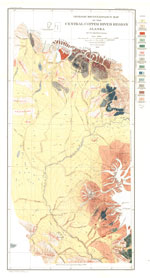
References
Pleistocene to Holocene Volcanism in the Canadian Cordillera, 2023
Russell, J.K., Edwards, B.R., Williams-Jones, G., and Hickson, C., 2023, Pleistocene to Holocene Volcanism in the Canadian Cordillera: Canadian Journal of Earth Sciences in press. Https://doi.org/10.1139/cjes-2023-0065.
Geologic database of information on volcanoes in Alaska (GeoDIVA), 2022
Cameron, C.E., Crass, S.W., and AVO Staff, eds, 2022, Geologic database of information on volcanoes in Alaska (GeoDIVA): Alaska Division of Geologic and Geophysical Surveys Digital Data Series 20, https://doi.org/10.14509/geodiva, https://doi.org/10.14509/30901.
Geospatial distribution of tephra fall in Alaska: a geodatabase compilation of published tephra fall occurrences from the Pleistocene to the present, 2018
Mulliken, K.M., Schaefer, J.R., and Cameron, C.E., 2018, Geospatial distribution of tephra fall in Alaska: a geodatabase compilation of published tephra fall occurrences from the Pleistocene to the present: Alaska Division of Geological & Geophysical Surveys Miscellaneous Publication 164, 46 p. http://doi.org/10.14509/29847
Geologic map of the Valdez D-1 and D-2 quadrangles (Mount Wrangell Volcano), Alaska, 2016
Richter, D.H., McGimsey, R.G., Labay, K.A., Lanphere, M.A., Moore, R.B., Nye, C.J., Rosenkrans, D.S., and Winkler, G.R., 2016, Geologic map of the Valdez D-1 and D-2 quadrangles (Mount Wrangell Volcano), Alaska: U.S. Geological Survey Scientific Investigations Map 3351, 20 p., scale 1:63,360, http://dx.doi.org/10.3133/sim3351.
Alaska Volcano Observatory image database, 2016
Cameron, C.E., and Snedigar, S.F., 2016, Alaska Volcano Observatory image database: Alaska Division of Geological & Geophysical Surveys Digital Data Series 13, https://www.avo.alaska.edu/images/. https://doi.org/10.14509/29689.
Preliminary database of Quaternary vents in Alaska, 2014
Cameron, C.E., and Nye, C.J., 2014, Preliminary database of Quaternary vents in Alaska: Alaska Division of Geological & Geophysical Surveys Miscellaneous Publication 153, 11 p., doi:10.14509/27357 .
Upper plate proxies for flat-slab subduction processes in southern Alaska, 2011
Finzel, E.S., Trop, J.M., Ridgway, K.D., and Enkelmann, Eva, 2011, Upper plate proxies for flat-slab subduction processes in southern Alaska: Earth and Planetary Science Letters, v. 303, n. 3-4, p. 348-360, doi:10.1016/j.epsl.2011.01.014 .

Changing ideas on the identity and stratigraphic significance of the Sheep Creek tephra beds in Alaska and the Yukon Territory, northwestern North America, 2008
Westgate, J.A., Preece, S.J., Froese, D.G., Pearce, N.J.G., Roberts, R.G., Demuro, M., Hart, W.K., and Perkins, W., 2008, Changing ideas on the identity and stratigraphic significance of the Sheep Creek tephra beds in Alaska and the Yukon Territory, northwestern North America: Quaternary International, v. 178, n. 1, p. 183-209, doi: 10.1016/j.quaint.2007.03.009.
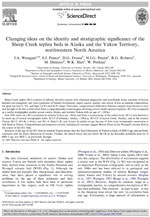
Ten years of monitoring the eruption of Shrub mud volcano, Alaska, 2007
McGimsey, R.G., Evans, W.C., Bergfield, D., McCarthy, S., and Hagstrum, J.T., 2007, Ten years of monitoring the eruption of Shrub mud volcano, Alaska [abs.]: Eos, v. 88, n. 52, abstract V13B-1345.
Geologic map of the Wrangell-Saint Elias National Park and Preserve, Alaska, 2006
Richter, D.H., Preller, C.C., Labay, K.A., and Shew, N.B., compilers, 2006, Geologic map of the Wrangell-Saint Elias National Park and Preserve, Alaska: U.S. Geological Survey Scientific Investigations Map 2877, 15 p., 1 plate, scale 1:350,000, available at http://pubs.usgs.gov/sim/2006/2877/ .
Bibliography of information on Alaska volcanoes, 2003
Cameron, C. E., Triplehorn, J. H., and Robar, C. L., 2003, Bibliography of information on Alaska volcanoes: Alaska Division of Geological & Geophysical Surveys Miscellaneous Publication MP 131, 1 CD-ROM.
Hard Copy held by AVO at FBKS - CEC file cabinet
1998 volcanic activity in Alaska and Kamchatka: Summary of events and response of the Alaska Volcano Observatory, 2003
McGimsey, R. G., Neal, C. A., and Girina, Olga, 2003, 1998 volcanic activity in Alaska and Kamchatka: Summary of events and response of the Alaska Volcano Observatory: U.S. Geological Survey Open-File Report 03-0423, 35 p.

A geologic guide to Wrangell-Saint Elias National Park and Preserve, Alaska: A tectonic collage of northbound terranes, 2000
Winkler, G. R., MacKevett, E. M. Jr., Plafker, George, Richter, D. H., Rosenkrans, D. S., and Schmoll, H. R., 2000, A geologic guide to Wrangell-Saint Elias National Park and Preserve, Alaska: A tectonic collage of northbound terranes: U.S. Geological Survey Professional Paper PP 1616, 166 p.

Volcanoes of Alaska, 1998
Nye, C. J., Queen, Katherine, and McCarthy, A. M., 1998, Volcanoes of Alaska: Alaska Division of Geological & Geophysical Surveys Information Circular IC 0038, unpaged, 1 sheet, scale 1:4,000,000, available at http://www.dggs.dnr.state.ak.us/pubs/pubs?reqtype=citation&ID=7043 .

Silicic materials in the Wrangell volcanic field, Alaska and their significance for the origin of distal type II tephra beds in interior Alaska, 1996
Preece, S. J., Hart, W. K., and Westgate, J. A., 1996, Silicic materials in the Wrangell volcanic field, Alaska and their significance for the origin of distal type II tephra beds in interior Alaska [abs.]: Abstracts with Programs - Geological Society of America, v. 28, n. 7, p. 504.
Hard Copy held by AVO at FBKS - CEC file cabinet
Volcanoes of the Wrangell Mountains and Cook Inlet Region, Alaska-selected photographs, 1996
Neal, Christina, and McGimsey, Robert, 1996, Volcanoes of the Wrangell Mountains and Cook Inlet Region, Alaska-selected photographs: U.S. Geological Survey Digital Data Series DDS 0039, 1 CD-ROM.

Guide to the volcanoes of the western Wrangell Mountains, Alaska - Wrangell-St. Elias National Park and Preserve, 1995
Richter, D. H., Rosenkrans, D. S., and Steigerwald, M. J., 1995, Guide to the volcanoes of the western Wrangell Mountains, Alaska - Wrangell-St. Elias National Park and Preserve: U.S. Geological Survey Bulletin 2072, 31 p.

Volcanoes of Alaska, 1995
Alaska Division of Geological & Geophysical Surveys, 1995, Volcanoes of Alaska: Alaska Division of Geological & Geophysical Surveys Information Circular IC 0038, unpaged, 1 sheet, scale 1:4,000,000.
Eruptive history and petrology of Mount Drum volcano, Wrangell Mountains, Alaska, 1994
Richter, D.H., Moll-Stalcup, E.J., Miller, T.P., Lanphere, M.A., Dalrymple, G.B., and Smith, R.L., 1994, Eruptive history and petrology of Mount Drum volcano, Wrangell Mountains, Alaska: Bulletin of Volcanology, v. 56, n. 1, p. 29-46.

Quaternary volcanism in the Alaska Peninsula and Wrangell Mountains, Alaska, 1994
Miller, T. P., and Richter, D. H., 1994, Quaternary volcanism in the Alaska Peninsula and Wrangell Mountains, Alaska: in Plafker, George, Jones, D. L., and Berg, H. C., (eds.), The Geology of Alaska, Geological Society of America The Geology of North America series v. G-1, p. 759-779.
Hard Copy held by AVO at FBKS - CEC file cabinet
Age and progression of volcanism, Wrangell volcanic field, Alaska, 1990
Richter, D. H., Smith, J. G., Lanphere, M. A., Dalrymple, G. B., Reed, B. L., and Shew, N., 1990, Age and progression of volcanism, Wrangell volcanic field, Alaska: Bulletin of Volcanology, v. 53, n. 1, p. 29-44.

Volcanoes of North America: United States and Canada, 1990
Wood, C. A., and Kienle, Juergen, (eds.), 1990, Volcanoes of North America: United States and Canada: New York, Cambridge University Press, 354 p.
Hard Copy held by AVO at FBKS - CEC shelf
Map showing distribution, composition, and age of Late Cenozoic volcanic centers in Alaska, 1986
Luedke, R. G., and Smith, R. L., 1986, Map showing distribution, composition, and age of Late Cenozoic volcanic centers in Alaska: U.S. Geological Survey Miscellaneous Investigations Series Map I 1091-F, unpaged, 3 sheets, scale 1:1,000,000.
The Wrangell WadBen zone, southern Alaska, 1984
Stephens, C. D., Fogleman, K. A., Lahr, J. C., and Page, R. A., 1984, The Wrangell WadBen zone, southern Alaska: Geology, v. 12, p. 373-376.
Uranium-series dating of fossil bones from the Canyon Creek vertebrate locality in central Alaska, 1984
Hamilton, T.D., and Bischoff, J.L., 1984, Uranium-series dating of fossil
bones from the Canyon Creek vertebrate locality in central Alaska: in
Reed, K.M., and Bartsch-Winkler, S. (eds.), The United States Geological Survey in Alaska: Accomplishments during 1982, United States Geological Circular 939, p. 26-29.
Geologic map of the Gulkana A-2 quadrangle, Alaska, 1979
Richter, D. H., Smith, R. L., Yehle, L. A., and Miller, T. P., 1979, Geologic map of the Gulkana A-2 quadrangle, Alaska: U.S. Geological Survey Geological Quadrangle Map GQ 1520, unpaged, 1 plate, scale 1:63,360.
Comprehensive tables giving physical data and thermal energy estimates for young igneous systems of the United States, 1978
Smith, R. L., Shaw, H. R., Luedke, R. G., and Russell, S. L., 1978, Comprehensive tables giving physical data and thermal energy estimates for young igneous systems of the United States: U.S. Geological Survey Open-File Report 78-0925, p. 1-25.
Hard Copy held by AVO at FBKS - CEC shelf
Katalog der geschichtlichen vulkanausbruche, 1917
Sapper, Karl, 1917, Katalog der geschichtlichen vulkanausbruche: Strassburg, Germany, Karl J. Trubner, 358 p.

Chemical analyses of igneous rocks, published from 1884 to 1913, inclusive, with a critical discussion of the character and use of analyses; a revision and expansion of Professional Paper 14, 1917
Washington, H. S., 1917, Chemical analyses of igneous rocks, published from 1884 to 1913, inclusive, with a critical discussion of the character and use of analyses; a revision and expansion of Professional Paper 14: U.S. Geological Survey Professional Paper PP 0099, 1201 p.
Conquering our greatest volcano, 1909
Dunn, Robert, 1909, Conquering our greatest volcano: Harper's Magazine, v. 118, p. 497-509.
Geology of the central Copper River region, Alaska, 1905
Mendenhall, W. C., 1905, Geology of the central Copper River region, Alaska: U.S. Geological Survey Professional Paper PP 0041, 133 p., 1 plate, scale 1:63,360.

The gold and mineral resources of a portion of the Copper River District, Alaska, 1901
Schrader, F.C., and Spencer, A.C., 1901, The gold and mineral resources of a portion of the Copper River District, Alaska: Washington, Government Printing Office, 94 p.
A reconnaissance of the Chitina River and the Skolai Mountains, Alaska, 1900
Rohn, Oscar, 1900, A reconnaissance of the Chitna River and the Skolai Mountains, Alaska, in Walcott, C.D., Twenty-first annual report of the director of the United States Geological Survey, 1899-1900 - Part II - General geology, economic geology, Alaska: U.S. Geological Survey Annual Report 21-II, p. 393-440. https://doi.org/10.3133/ar21_2.
A reconnaissance of a part of Prince William Sound and the Copper River District, Alaska, in 1898, 1900
Schrader, F.C., 1900, A reconnaissance of a part of Prince William Sound and the Copper River District, Alaska, in 1898, in Walcott, C.D., Twentienth annual report of the United States Geological Survey, Part VII - Explorations in Alaska in 1898: U.S. Geological Survey Annual Report 20-VII, p. 341-424. https://doi.org/10.3133/ar20_7.
Before an eruption
Ashfall & Preparedness Information
- Ashfall impacts & preparedness (US Geological Survey)
- Volcanic health hazards & impacts (International Volcanic Health Hazards Network)
- Ash Alert! Pamphlet (AK Division of Homeland Security & Emergency Management)
- Volcanic Ashfall (AK Department of Environmental Conservation, Division of Air Quality)
